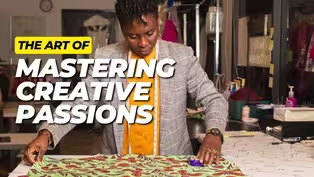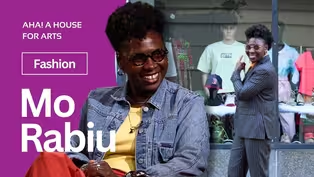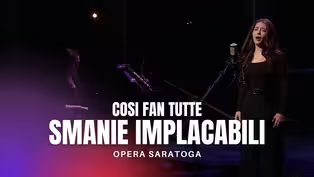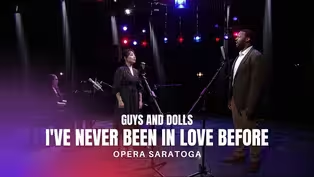
Transforming Beeswax into Art
Clip: Season 9 Episode 24 | 7m 57sVideo has Closed Captions
Explore Laura Moriarty's art made with pigmented beeswax in Rosendale, NY.
Join us as we visit Laura Moriarty in Rosendale, NY, to uncover her unique art form using pigmented beeswax.
Problems playing video? | Closed Captioning Feedback
Problems playing video? | Closed Captioning Feedback
AHA! A House for Arts is a local public television program presented by WMHT
Support provided by the New York State Council on the Arts (NYSCA), M&T Bank, the Leo Cox Beach Philanthropic Foundation, and is also provided by contributors to the WMHT Venture...

Transforming Beeswax into Art
Clip: Season 9 Episode 24 | 7m 57sVideo has Closed Captions
Join us as we visit Laura Moriarty in Rosendale, NY, to uncover her unique art form using pigmented beeswax.
Problems playing video? | Closed Captioning Feedback
How to Watch AHA! A House for Arts
AHA! A House for Arts is available to stream on pbs.org and the free PBS App, available on iPhone, Apple TV, Android TV, Android smartphones, Amazon Fire TV, Amazon Fire Tablet, Roku, Samsung Smart TV, and Vizio.
Providing Support for PBS.org
Learn Moreabout PBS online sponsorshipI am here in Rosendale, New York to meet with artist Laura Moriarty and to learn more about her beautiful art made with pigmented beeswax.
Follow me.
(whimsical music) - I make sculptures and works on paper out of pigmented beeswax.
It's sort of a form of naturalism for me.
It's a way of investigating the processes of nature, using just this one material.
(gentle music) Beeswax has been used in art for a really long time, like the Fayum mummy portraits, they're ancient.
There's oil paint, which is oil based.
There's watercolor, which is water based.
There's acrylic, which is acrylic based, and there's encaustic, which is wax based.
Yeah.
- And this is it right here.
- Yeah, now this is just the bees wax and the resin.
It would be just the raw medium that you're working with.
These are milled paints.
So these are the beeswax and the resin, and then they're milling pigment into it.
They just come in.
- [Matt] Hockey pucks.
- Yeah.
(whimsical music) I had been experimenting with beeswax as a way of giving my work on paper more heft, more physicality.
So I just kind of transitioned over to just working with the wax.
It's starts off like a traditional painting.
I'm on a panel, I'm using a brush, I'm melting the color, and I'm just painting it on the panel.
(whimsical music) So letting this cobalt blue melt out into a puddle.
The qualities of the medium are that it, well, first of all, it goes from solid to liquid.
You have all these opportunities between the fluidity and the solidity to do different things with it.
And you see how it's always moving when it's hot, when it's fluid.
(whimsical music) And I make layers.
So I'm building up layers of color.
- Cooling off the panel.
- I'm cooling this off because it's not settling.
- Must be all the hot film lights.
- And I just pile colors on top of each other.
Then at a certain point, I push the paint off the panel.
So this is gonna be very thin, but you know, just pushing it up off the panel.
And you can imagine if I had a lot of paint on there, that this would be.
- [Matt] Different layers.
- It would be like this.
Imagine that it's this much paint, but I mean, this object was made absolute, exactly this way.
(whimsical music) I'm using the poetics of geology very deliberately.
The subsuming and enfolding, erosion.
There was a point when I was literal about like looking at geology textbooks, looking at those diagrams of cross sections, and I was kind of evaluating like, what are these illustrating, and how can I illustrate that in a parallel way?
Over the years, I've just gotten looser and looser and looser with it.
And now I make these very strange objects that, you know, to me, they're never finished.
They're incomplete.
They're always in process.
And I think of myself the same way.
Like I am in this process too, and we're always gonna be in this process.
The work on paper started off as a byproduct of the sculptural work.
You know, I have this ecological kind of mandate in the studio where I really try not to waste anything.
So when I was making the sculptural pieces, I would do a lot of eroding on a hot pallet where I'm dragging the form along a hot palette and it's melting.
So I started picking those things up on paper, almost like a monotype or a monoprint, you know, in a way the works on paper were almost like cross sections and microscopic where you're seeing the thinnest slice of a rock.
And now I actually do more work on paper than sculpture.
Well, why don't you give it a try now?
(triumphant music) - I don't know what I'm doing.
I have a good teacher.
Okay.
(triumphant music) (gentle music) It's my first one.
It's not going to be beautiful, as perfect as you know, it's a student's piece.
Ooh.
- [Laura] Oh.
- [Matt] It looks nice on paper.
- Yeah.
(gentle music) I don't know.
It's kind of beautiful.
- [Matt] It's not bad, yeah.
- And I like this side of this one.
- [Matt] Yeah.
- It's really smooth and it kind of reminds me of a Gerhard Richter.
- I'm Gerhard Richter.
(Laura laughs) (gentle music) - I think of my practice as a form of spiritual practice.
You know, it is the most important thing to me.
It's the way I try to reflect back out at my culture.
Naturalism has always been really important to me.
You know, I'm committed to nature, to living in harmony with it, and to accepting my place in it.
And I reject a lot of philosophy that places humans in the center of everything.
I don't believe that.
I believe we're just one of the many species on the earth and there's all forms of matter.
And I really go very deep into thinking about how this is sort of a way of thinking about oblivion, of thinking about how nothing goes anywhere.
Nothing goes away.
Everything is here and it's constantly shifting shape, shifting form.
These objects are my way of investigating that and sort of giving people an opportunity to have that experience for themselves.
The Art of Mastering Creative Passions: Preview
Video has Closed Captions
Preview: S9 Ep24 | 30s | Explore beeswax art, fashion tailoring, and opera in this episode of "AHA, A House for Arts." (30s)
Mo Rabiu's Impact on the World of Modern Tailoring
Video has Closed Captions
Clip: S9 Ep24 | 6m 24s | Mo discusses his inspiring journey from finance to sustainable fashion design. (6m 24s)
Opera Saratoga Performs Cosi Fan Tutte "In Uomini, In Soldati"
Video has Closed Captions
Clip: S9 Ep24 | 2m 33s | Watch Opera Saratoga perform excerpts from their current season. (2m 33s)
Opera Saratoga Performs Cosi Fan Tutte "Smanie Implacabili"
Video has Closed Captions
Clip: S9 Ep24 | 3m 10s | Watch Opera Saratoga perform excerpts from their current season. (3m 10s)
Opera Saratoga Performs Guys And Dolls "I've Never Been In Love Before"
Video has Closed Captions
Clip: S9 Ep24 | 4m 1s | Watch Opera Saratoga perform excerpts from their current season. (4m 1s)
Providing Support for PBS.org
Learn Moreabout PBS online sponsorshipSupport for PBS provided by:
AHA! A House for Arts is a local public television program presented by WMHT
Support provided by the New York State Council on the Arts (NYSCA), M&T Bank, the Leo Cox Beach Philanthropic Foundation, and is also provided by contributors to the WMHT Venture...
















